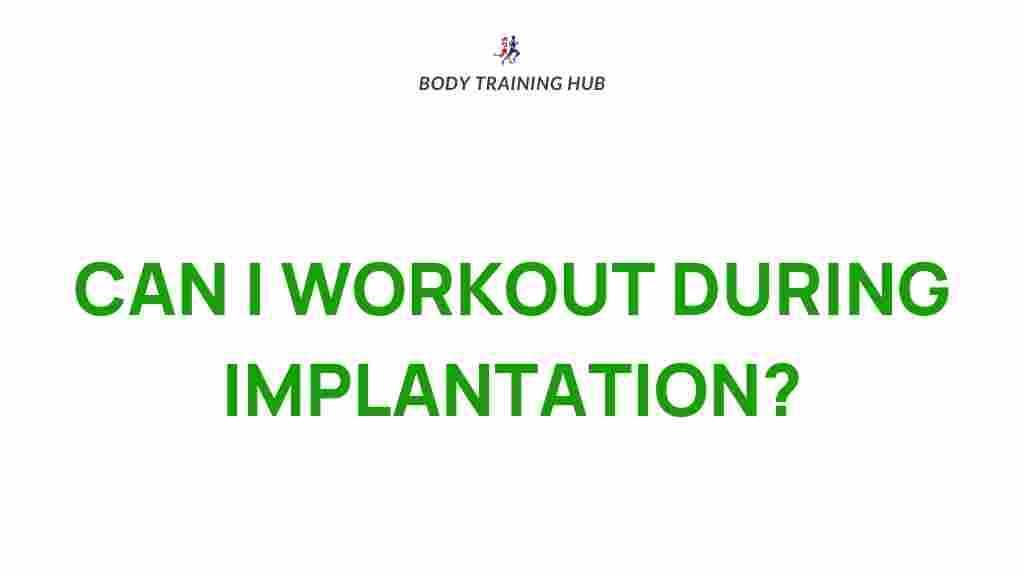Workout: Understanding Exercise During Implantation
Implantation is a crucial step in early pregnancy, occurring when a fertilized egg attaches to the uterine lining. Naturally, individuals undergoing this process, whether naturally or via assisted reproductive technology (ART), are concerned about how lifestyle choices, particularly a workout, might impact implantation success. This article delves into the facts, separating myths from realities and providing actionable tips for exercising during this delicate phase.
What Happens During Implantation?
Implantation typically occurs 6-10 days post-ovulation. During this time, the fertilized egg burrows into the uterus, establishing a connection to receive nutrients and oxygen. It’s a complex and sensitive process influenced by hormonal changes and uterine receptivity. Understanding these physiological dynamics helps contextualize concerns about workouts during implantation.
Can Exercise Affect Implantation?
The relationship between physical activity and implantation success is nuanced. Moderate physical activity is generally considered safe and even beneficial. However, overly intense workouts might potentially elevate stress hormones like cortisol, which could interfere with hormonal balance. Key considerations include:
- The intensity and type of exercise.
- Personal fitness level and baseline activity.
- Medical advice tailored to individual health conditions.
Safe Workout Guidelines During Implantation
If you’re planning to exercise during implantation, following these guidelines ensures safety and enhances overall well-being:
1. Prioritize Low-Impact Workouts
Activities like walking, yoga, or light stretching are ideal. These exercises promote circulation without placing excessive strain on the body.
2. Avoid High-Intensity Training
Intense activities such as heavy weightlifting or endurance running should be minimized during this period to reduce stress on the body.
3. Stay Hydrated and Rested
Proper hydration and sufficient rest are integral parts of any workout routine, particularly during implantation. This helps the body maintain optimal conditions for embryo attachment.
4. Listen to Your Body
If you feel discomfort, fatigue, or any unusual symptoms, take a break. Overexertion can be counterproductive.
Common Myths About Workouts and Implantation
Misinformation can lead to unnecessary anxiety. Let’s debunk some common myths:
- Myth: Any workout will disrupt implantation. Fact: Moderate exercise is generally safe.
- Myth: You must avoid all movement post-ovulation. Fact: Gentle activity is beneficial for circulation.
- Myth: Stress from exercise always harms implantation. Fact: Stress reduction from enjoyable workouts can actually help.
Troubleshooting Workout-Related Concerns
If you’re unsure about your current exercise routine, here are some tips to address concerns:
- Feeling Tired: Reduce workout intensity or duration.
- Abdominal Discomfort: Avoid exercises involving core engagement, like crunches.
- Increased Anxiety: Switch to calming activities like meditation or prenatal yoga.
If symptoms persist, consult a healthcare provider for personalized advice.
Benefits of Light Workouts During Implantation
Moderate exercise not only poses minimal risks but can also provide numerous benefits:
- Improved blood flow to the reproductive organs.
- Enhanced mental well-being and reduced stress.
- Support for overall physical fitness, benefiting long-term pregnancy health.
When to Avoid Exercise
While moderate activity is beneficial, there are situations where rest should take precedence:
- If instructed by a doctor due to medical conditions or risks.
- After procedures like embryo transfer during IVF.
- When experiencing cramping, spotting, or other warning signs.
Always prioritize your health and follow professional advice.
Resources for More Information
For further insights into exercise and fertility, explore our comprehensive guide to reproductive health. Additionally, external resources such as ACOG provide expert guidelines on physical activity during pregnancy and related phases.
Conclusion
Exercising during implantation doesn’t have to be daunting. By opting for safe and moderate workouts, you can maintain physical and mental well-being while supporting your fertility journey. Remember, every individual is unique, so always consult your healthcare provider to tailor a plan suited to your needs. Stay active, stay informed, and embrace this transformative phase with confidence!
This article is in the category Myths & Facts and created by BodyTraining Team
